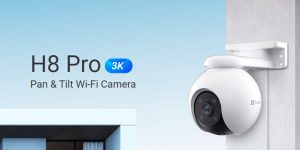
The Sonos Move is an expensive portable speaker, but the clever connection it offers and the high-quality sound it produces more than make up for the cost. It’s really a bad that it can’t be included into a stereo sound system.
Specification
- Weighs: 6.61 ounces
- To be specific, Bluetooth 5.0.
- 10 hours of continuous use is the average for modern batteries.
- Comprised of 1GB of SDRAM and 4GB of NV
- Amazon Alexa and Google Assistant are both voice assistants that can be integrated.
- Isolation from dust and water: IP56
- Shades of Black and White from the Moon
- Audio amplification provided by two digital Class-D amplifiers.
| Pros | Cons |
| Quality construction throughout. | Bass compression at highest loudness. |
| Plenty excellent choices for wireless connectivity. | There is no true EQ; merely sliders for adjusting the bass and treble. |
| Carry using only one hand | |
| Excellent directivity. |
The Move became the first Bluetooth as well as Wi-Fi-enabled portable speaker from a premium audio company. You can find a Sonos smart speaker for any event, and the company’s reach only grows from there. You may also want to know about Sennheiser Presence.
The company has released a number of new products, including the portable and compact Roam speaker, the Ray, Arc, and Beam soundbar trio, and the premium wireless subwoofer, Sub. The brand also includes bookshelves and lights as a result of a recent partnership with Ikea. In other words, it’s not to be trifled with.
When Sonos debuted the Sonos move Bluetooth in 2019, it was the first time the firm had dabbled in Bluetooth speakers that could be taken anywhere. Since its release, it has been featured prominently in our rundown of the best Bluetooth speakers because of how well it works in both indoor and outdoor settings.
The Sonos Moves Bluetooth pairing is a portable Bluetooth speaker that also connects wirelessly to a home sound system with several zones. Because of this, it has most of the features of a standard Sonos, plus the enticing bonus of being able to use it without being tethered to an outlet.
Where will Sonos be available, and at what cost?
On September 24, 2019, the Sonos Move debuted for retail at a price of $399 (£399, AU$ 649). This isn’t your standard Bluetooth boombox, so it’s hard to compare it to the competition. The Sonos Move’s premium price tag is understandable, given that it has a more robust feature set than other portable speakers (even those with built-in smart assistants).
As no other Sonos product is designed for the same use case and demographic, making comparisons to the Move is also difficult. sonos roam vs move comes the closest to being a comparable product. Like the Sonos Move Lite, I guess. It’s a budget-friendly outdoor speaker that can be yours for only $169 (or £159, or AU$279) thanks to its lightweight design and waterproof construction. As it lacks the strength of the Move, one may purchase it at a fraction of the price.
Bose introduced the Bose Portable Home Speaker not long after the Sonos Move, and we consider them to be the most direct competition you’ll find in this space. It is presently available for $349 (or £369.95 or AU$499.95), making it cheaper than the Move by a small amount. Nevertheless, this goes to demonstrate that if a high-end audio manufacturer can make a product that sounds and looks this well, they can get away with charging a hefty premium.
Of course, you can get wireless speakers with some of the same capabilities as the Move for a lot less money, but you shouldn’t expect them to sound nearly as good or offer the same outstanding connectivity options as the reset Sonos move does. You may be interested in The Best Audiobook Services.
There’s something for every budget in our comprehensive best Bluetooth speaker list. You can get good sound on the Move for as low as $80 (or £64.99, or AU$140) if you check our evaluation of the Anker Soundcore Flare 2.
Designed and made to high standards, Move
It looks and acts similarly to other Sonos products. A black speaker with a metal grille in front, four far-field microphones arrayed along the top, and capacitive playback control buttons. There are buttons for power, Bluetooth connectivity, and wireless hotspot accessibility clustered around the back.
In terms of the audio innards, the Move utilizes a pair of Class-D digital amps, one descending tweeter for highs, and one mid-woofer embedded further into the enclosure for mid-ranges & bass. Moreover, the Sonos Move has a built-in battery that allows it to play music for up to eight hours on a single charge. As there are no limitations in the outer world, Sonos made the enclosure cutaway resonant and well-balanced from any angle. The Jabra Steel Bluetooth headset also delivers outstanding performance.
Being a compact product, it’s been thoroughly tested for durability. The Sonos Move, the company’s portable speaker, is weatherproof and can operate in a wide range of temperatures, meaning it can play music in the deserts or in the snow during a storm without skipping a beat.
You may drop it into the pool and not worry about damaging it, as it has an IP56 rating and is protected against dust and water. Sonos states that a concrete slab cracked before the speaker was damaged during drop testing, and the speaker’s shell is equipped with run-off channels to facilitate water drainage.
We attribute that to its heaviness. One may carry it about easily despite its size, which is 240 by 160 by 126 millimeters. You can easily pick up the Sonos Move, which weighs in at just under 3 kilograms, but you really shouldn’t. That’s an inevitable consequence of the big driver magnets used, and it’s a reasonable cost to pay for excellent sound reproduction. The case features a concave, handle-shaped cutout on the back to make transporting it around less of a chore.
The Sonos Move’s battery life
As far as we can tell from our tests, the battery life is really 10 hours long, and it takes around 2.5 hours to charge completely. You can charge the speaker through USB-C, but you’ll probably just utilize the docking base ring that comes with it.
The Sonos move battery life also employs a standby-like mode to save power when it sees it hasn’t been used for 30 minutes or so — this allows it to preserve power for up to 5 days without a charge but also provides it with enough energy to enable it to be roused from its nap wirelessly.
Also, this product has some respectable environmental characteristics. After around 900 charge cycles or about three years of regular use, Sonos Move reset estimates that battery deterioration will begin to occur. Instead of making you throw away your expensive speaker, it will sell you a replacement battery that you can pop into the bottom of the device yourself and use for a cost that has not yet been disclosed.
benefits of Sonos Moving
Since this is Sonos’ first foray into portable audio, you shouldn’t expect any less of the company’s signature wireless and networked audio quality. The Move, like other Sonos speakers, may be set up for stereo use or used as part of a larger multi-room audio system. With a Sonos system, the Move can play the same music in the yard as it can in any other room of the house.
The Sonos Move is compatible with any networked audio source, whether it is hosted online or on a local device. Spotify Connect makes it as easy to play a playlist as it is to play the music that you have ripped to a networked storage device from within the app. After initial setup and internet connectivity, the Sonos app will display all of your sources through Wi-Fi.
Bluetooth is a backup connection option when you’re not near a Wi-Fi hotspot. Although it uses Bluetooth’s older 4.2 standards rather than the more modern 5.0, Sonos says it has found ways to increase the technology’s power efficiency and range thanks to its extensive expertise with the older version.
If you can hear it, you can operate it, but it doesn’t specify the range of its Bluetooth or Wi-Fi connections. Four Wi-Fi antennae lie sprinkled around the base of the Move, with the Bluetooth module located on top to offer the greatest coverage possible. For those of you who only use Apple products, don’t worry; AirPlay 2 is also supported.
That cluster of microphones up above does double duty. The Sonos Move is compatible with both the Amazon Alexa and Google Assistant voice assistants, so you can choose which one you like to use for tasks like voice-activated to-do lists, smart-home device management, calendar access, and music playback.
The microphones and smart assistant combo work beautifully here. It was able to pick up our requests even across a noisy workplace with the speaker playing a song by The National, albeit the replies weren’t always what we were looking for. Yet, this is the fault of the AI assistants at Amazon and Google and not the work of Sonos’ developers.
Secondly, the mics are also the heart of the ‘Trueplay’ audio-tweaking mechanism. They assess the output from the pairing Sonos move and how its surroundings are impacting it, then automatically modify it to get it closer to the intended studio sound. Smartly, the Sonos Move incorporates an integrated accelerometer that activates the TruePlay system’s adjustments when motion is detected.
Unlike other Sonos products, the Move isn’t compatible with 5.1 surround sound systems. Thus it can’t be utilized as an additional speaker in a home theatre setup. Sonos argues that this is due to sync difficulties and the troublesome possibility for a directional soundtrack to lose its focus if a speaker may be displaced in a room. Yet considering the promise of delivering wire-free surround sound, this is a real disappointment.
fidelity of sound
If you’re looking for a portable speaker, the Sonos Move isn’t it. If you’re already familiar with the home audio equipment made by Sonos, you’ll know that this falls between the Sonos One and the Play:5 in terms of both loudness and sound quality.
In contrast to less capable portable speakers, the mid-range driver provides a robust and room-filling bottom end, even when contending with the acoustics of a large open area, without sacrificing vocal purity. The Sonos Move’s battery allows it to compete with the Sonos home range.
As the speaker will likely be relocated to other rooms (and perhaps the backyard) with varying acoustic conditions, the TruePlay mechanism is activated. It does a remarkable job of adjusting the sound to fit a variety of settings. A member of the Sonos crew played Billie Eilish’s “bad man” at the launch event for the Sonos Move, and the audience went wild.
They started with the music playing superbly from atop a TV stand. They hid the speaker in a partially opened drawer and continued singing. At first, it didn’t sound great; the bass boomed too loudly, masking any production nuance in the music, and the vocals lost some of their definition. The Trueplay system took roughly 20 seconds to analyze its surroundings using the built-in microphone, at which point Where somewhat toned down the bass, and the overall experience was once again rather pleasant. This demonstration of the system’s capability was really amazing.
The loudspeaker can hold its own in any environment. When testing a new headset, the TechRadar crew attracted attention by playing ABBA songs (a guilty pleasure) at deafening decibel levels in a public park. Again, its low-end power and clarity were not diminished by the passing of automobiles and sirens. A homeowner probably won’t take their Sonos Move too far from their garden, but you’ve got enough juice here to cover a (small) field with sound easily. Find the best juicers here.
It’s worth noting that some newer Sonos speakers now offer Hi-Res Audio streaming, beating out competitors like Tidal and Amazon Music HD to become the first Hi-Res streaming service to be supported by the multi-room ecosystem.











